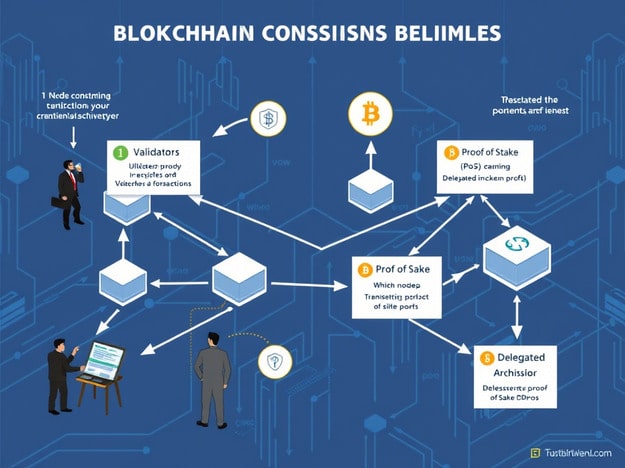Introduction: Why Consensus Matters in Blockchain
At the heart of every blockchain lies a consensus mechanism —a set of rules that ensures all participants (nodes) agree on the state of the network. Without consensus, decentralized systems would collapse into chaos, vulnerable to double-spending, fraud, and conflicting transaction records. This article unpacks how these mechanisms work, their pros and cons, and why they’re critical for the future of Web3.
1. Proof of Work (PoW): The Original Pioneer
How It Works :
- Miners solve complex mathematical puzzles to validate transactions and create new blocks.
- The first miner to solve the puzzle broadcasts the solution to the network, and other nodes verify it.
- Reward : Miners earn newly minted coins (e.g., Bitcoin) and transaction fees.
Example : Bitcoin, Litecoin, and Monero use PoW.
Strengths :
- Security : PoW is battle-tested and resistant to Sybil attacks (attackers cannot easily forge computational power).
- Decentralization : Open to anyone with mining hardware.
Weaknesses :
- Energy Consumption : High electricity use (e.g., Bitcoin’s annual energy consumption rivals countries like Argentina).
- Scalability : Slow transaction speeds (Bitcoin processes ~7 TPS).
SEO Keywords : “Proof of Work explained,” “Bitcoin mining consensus.”
2. Proof of Stake (PoS): Energy-Efficient Evolution
How It Works :
- Validators are chosen to create blocks based on the number of coins they “stake” (lock up) as collateral.
- Validators propose and vote on blocks; malicious actors risk losing their staked funds.
- Reward : Validators earn transaction fees and staking rewards.
Example : Ethereum (post-Merge), Cardano, and Solana.
Strengths :
- Energy Efficiency : Uses ~99% less energy than PoW.
- Scalability : Faster transactions (e.g., Solana achieves 50,000+ TPS).
Weaknesses :
- Wealth Centralization : Validators with more staked coins have disproportionate influence.
- Slashing Risk : Validators can lose funds for downtime or malicious behavior.
SEO Keywords : “Proof of Stake vs. Proof of Work,” “Ethereum staking.”
3. Delegated Proof of Stake (DPoS): Democracy in Action
How It Works :
- Coin holders vote for “delegates” to validate blocks and govern the network.
- Delegates rotate frequently to prevent centralization.
Example : EOS, Tron, and Lisk.
Strengths :
- Speed : High throughput (EOS claims 4,000+ TPS).
- Governance : Community-driven decision-making.
Weaknesses :
- Centralization Risk : A small group of delegates controls the network.
- Voter Apathy : Low participation can lead to unrepresentative governance.
4. Proof of Authority (PoA): Trust Over Computation
How It Works :
- Validators (authorities) are pre-approved based on reputation or identity.
- Blocks are validated by these trusted nodes.
Example : VeChain, POA Network.
Strengths :
- Speed : Extremely fast and low-cost transactions.
- Efficiency : No need for energy-intensive mining.
Weaknesses :
- Centralization : Trust in validators undermines decentralization ethos.
- Limited Use Cases : Best for private/permissioned blockchains.
5. Proof of Burn (PoB): Sacrifice for Security
How It Works :
- Miners “burn” (destroy) coins to earn the right to validate blocks.
- Burning coins reduces supply, theoretically increasing scarcity.
Example : Slimcoin, Counterparty.
Strengths :
- No Energy Waste : Burns coins instead of electricity.
- Long-Term Security : Miners have a vested interest in the network’s success.
Weaknesses :
- Deflationary Risk : Excessive burning can harm liquidity.
- Complexity : Less intuitive for new users.
6. Proof of Space/Time (PoST): Harnessing Storage
How It Works :
- Participants allocate hard drive space to store cryptographic proofs.
- More storage = higher chance of being chosen to validate blocks.
Example : Filecoin, Chia.
Strengths :
- Eco-Friendly : Uses idle storage instead of computational power.
- Decentralization : Accessible to anyone with spare hard drive space.
Weaknesses :
- Hardware Costs : Requires significant storage investment.
- Network Congestion : Large files can slow down validation.
Comparing Consensus Mechanisms: Which Is Best?
The “best” consensus mechanism depends on a blockchain’s goals:
SEO Tip : Use comparison tables to target keywords like “blockchain consensus comparison” or “PoS vs. PoW.”
The Future of Consensus: Hybrid Models and Innovations
Emerging mechanisms aim to combine the best of multiple systems:
- Proof of History (PoH) : Used by Solana, timestamps transactions to reduce latency.
- Liquid Proof of Stake (LPoS) : Tezos’ upgrade allows stakers to delegate voting power dynamically.
- Zero-Knowledge Proofs (ZKPs) : Enhance privacy and scalability (e.g., zk-SNARKs in Zcash).
CTA : Explore cryptorex.net’s Consensus Mechanism Guide for in-depth tutorials and protocol comparisons.
Why Consensus Mechanisms Matter for Crypto Users
Understanding these systems helps users:
- Choose Platforms : Align investments with energy-efficient or high-speed blockchains.
- Participate : Mine, stake, or delegate to earn passive income.
- Stay Secure : Recognize vulnerabilities (e.g., 51% attacks on PoW networks).
Conclusion: The Evolution of Trust
Consensus mechanisms are the unsung heroes of blockchain technology, enabling trustless collaboration at scale. As the crypto ecosystem evolves, so too will these systems—balancing security, speed, and sustainability. Whether you’re a developer, investor, or enthusiast, grasping these concepts is key to navigating the decentralized future.




Add Comment